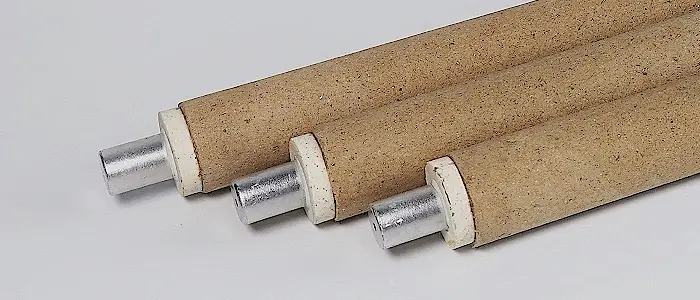In the high-stakes world of molten metal processing, where temperature is the critical variable governing quality, efficiency, and safety, a unique class of sensor reigns supreme: the fast thermocouple, or disposable thermocouple. This unsung hero of foundries and steel mills worldwide provides a masterclass in delivering precision where it matters most, under the most extreme conditions imaginable.
For international professionals in metals manufacturing, understanding this technology is not just an operational detail—it’s a cornerstone of quality control.
What Exactly is a Fast Thermocouple?
A fast thermocouple is a consumable temperature sensor designed for a single, ultra-fast measurement of molten metals, such as steel, iron. Unlike traditional durable thermocouples meant for continuous monitoring, a fast thermocouple is engineered for a specific, brutal task: to be immersed into a molten bath, provide an accurate temperature reading within seconds, and be discarded after use.
Think of it as a high-precision, single-use thermometer for industry.
How Fast Thermocouple Works
The system comprises three key components:
The Disposable Probe Tip: This is the heart of the system. It contains:
Thermocouple Wire: Fine wires of specific alloys (e.g., Type S, B, or R for high temperatures) welded together at the tip to form the measuring junction.
Quartz Tube: A U-shaped quartz tube protects the delicate wires from thermal shock and provides electrical insulation.
Protection Cap: A cap made of high-temperature refractory material shields the assembly from slag and physical impact during immersion.
Plug Connection: A standardized plastic or ceramic plug ensures a secure and reliable connection to the reusable lance.
The Thermocouple Lance (or Gun): A long, water-cooled steel tube that allows operators to safely immerse the probe tip into the molten metal from a distance. It houses a length of compensating cable that transmits the electrical signal back to the display unit.
The Temperature Display Unit: This instrument receives the millivolt (mV) signal from the thermocouple, applies cold-end compensation, and converts it into a accurate temperature reading displayed on a digital screen.
The principle is based on the Seebeck Effect: when two dissimilar metals joined at one end (the “hot junction”) are exposed to heat, they generate a small electrical voltage proportional to the temperature difference between the hot junction and the other end (the “cold junction”).
Why Choose a Fast Thermocouple? Key Advantages
-
Unmatched Speed and Response Time: With a thermal mass measured in milliseconds, these probes can achieve a accurate reading in 3 to 5 seconds. This speed is crucial to capturing the true temperature before the probe is consumed.
-
Superior Accuracy: Because each measurement is taken with a brand-new, factory-calibrated thermocouple element, there is no risk of signal drift, contamination, or degradation that can plague permanent sensors. Every reading is as accurate as the first.
-
Operational Safety and Simplicity: The system allows personnel to perform critical measurements from a safe distance. The process is simple: connect a new probe, immerse, record the temperature, and discard.
-
Cost-Effectiveness: While a continuous sensor requires significant capital investment, maintenance, and recalibration, the consumable model of fast thermocouples transforms a large capital expense into a predictable, manageable operating cost. The cost of a single probe is negligible compared to the value of a perfectly tempered batch of metal or the cost of a scrapped heat.
Primary Applications Across the Metals Industry
Fast thermocouples are indispensable in virtually every segment of primary and secondary metals production:
Steelmaking: Measuring temperature in basic oxygen furnaces (BOF), electric arc furnaces (EAF), ladle furnaces, and tundishes.
Iron Foundries: Determining the precise pouring temperature of iron in cupolas and induction furnaces.
Non-Ferrous Metal Production: Critical for temperature control in the smelting and casting of aluminum, copper, brass, and zinc alloys.
Die-Casting: Ensuring optimal metal temperature before injection into dies.

Selecting the Right Type: A Matter of Material and Temperature
The choice of probe is primarily determined by the melting point of the metal being measured:
Type S (Platinum Rhodium – 10% / Platinum): The industry standard for steel and high-temperature alloys. Ideal for measurements up to 1450°C (2642°F), with short-term tolerance up to 1600°C (2912°F).
Type B (Platinum Rhodium – 30% / Platinum Rhodium – 6%): Designed for the most extreme environments, such as superheating in ladle furnaces. Excellent for sustained measurements above 1600°C and up to 1800°C (3272°F).
Type R (Platinum Rhodium – 13% / Platinum): Offers similar performance to Type S, with a slightly higher output and temperature range, often used in glass and ceramic industries as well.
Conclusion: An Indispensable Tool for Modern Metallurgy
In an industry where margins are thin and quality is paramount, the fast thermocouple stands out as a perfect fusion of simplicity, reliability, and precision. It elegantly solves the problem of measuring the unmeasurable, providing a critical data point that directly impacts product quality, energy consumption, and operational safety.
For global manufacturers committed to excellence, partnering with a supplier that provides consistent, high-quality fast thermocouples is not just a purchase—it’s an investment in the integrity of your final product.


